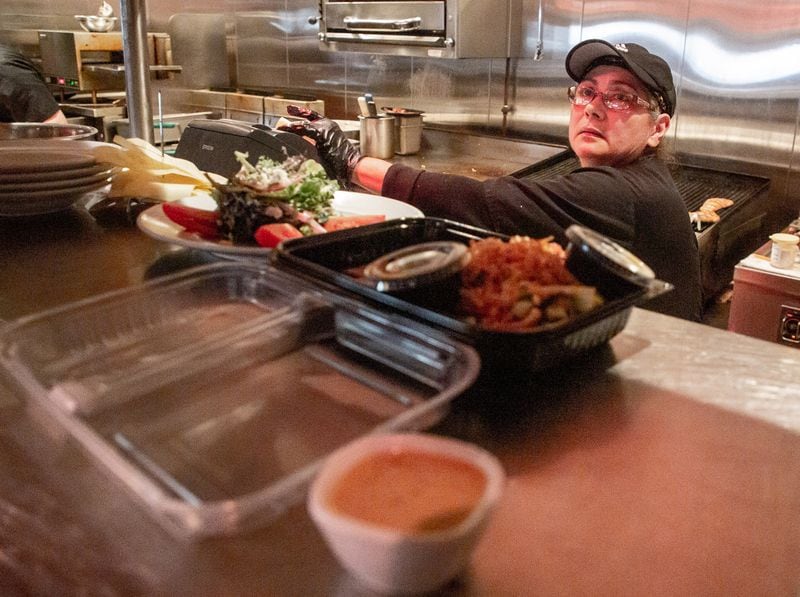The economy as a whole has also changed, nationally and in Georgia, driven by changing behaviors of tens of millions of consumers who have spent their money and time differently as COVID-19 disrupted daily life. .
The coronavirus has killed more than 900,000 Americans and burdened millions more with lingering symptoms. In its economic wake, some businesses were battered, others were strengthened, and the values of hard work and loyalty suddenly changed.
In many ways, the economy has proven resilient.
After more than a year of sometimes frantic growth, employment numbers in Georgia are finally back to pre-pandemic levels. Nationwide, hundreds of billions of dollars in emergency government spending have saved many businesses and people from bankruptcy.
Sectors with more jobs at the end of 2021 than before the pandemic in Georgia:
- Professional and business services
- Manufacturing
- Health care
- Food manufacturing
Sectors with fewer jobs at the end of 2021 than before the pandemic in Georgia:
- Leisure and hospitality
- State and local government
- Construction
- Personal and laundry services
- Air Transport
- Hospitals
Source: Bureau of Labor Statistics
By some measures, the economy is stronger. The country’s gross domestic product, the broadest measure of economic growth, rose 10% last year, more than double the pace of 2019. Consumer spending has increased.
Some people are richer. The S&P 500, a broad stock index, is up about 27% from its pre-pandemic level, despite falling since December. Home prices soared more than 20% last year in the Atlanta metro area.
This propelled renovation and repair spending, a boon for contractors, but also for businesses like Home Depot. Sales at the Vinings-based retailer jumped 14% last year, topping $150 billion for the first time.
Wages and salaries are also generally on the rise. The average salary is growing at an annual rate of more than 5%, according to the Federal Reserve Bank of Atlanta.
Percentage of workers whose work could be done remotely: about 75 million
Workers whose work can be performed remotely who work from home: 59%
Daily reduction in commuting time while working from home, first 18 months of pandemic: 62.4 million hours
Sources: Global Workplace Analytics, FlexJobs
In other respects, however, the economy is weaker and more vulnerable. Labor and material shortages have slowed production and transportation of goods, stoking inflation. Consumer prices in the United States rose 7% last year, eclipsing wage increases. Many people who do not own stocks or houses are worse off today.
And that was before Russia invaded Ukraine, sending gas prices skyrocketing in Georgia and injecting further uncertainty about the direction the economy will take.
Erice Ford, sous chef at Marlow’s Tavern, works through both meals and takeout orders during their lunch rush on Friday, March 11, 2022. STEVE SCHAEFER FOR THE ATLANTA JOURNAL-CONSTITUTION
Credit: Steve Schaefer
Credit: Steve Schaefer
Erice Ford, sous chef at Marlow’s Tavern, works through both meals and takeout orders during their lunch rush on Friday, March 11, 2022. STEVE SCHAEFER FOR THE ATLANTA JOURNAL-CONSTITUTION
Credit: Steve Schaefer
Credit: Steve Schaefer
What is clear, however, is that the local economy is very different from what it was at the start of 2020:
- Many companies sent workers home when the pandemic started. Many have continued to work remotely and may never fully return to their offices. Workers who do not go to the office do not frequent restaurants for lunch or bars after work.
- Consumers spooked by a deadly virus are spending less money at gyms, theaters, concerts and in-person services like hair salons. Instead, they spend more on goods – treadmills, televisions, pressure cookers, pajamas – which can often be delivered to their homes.
- People whose business events have been canceled — or are taking place on Zoom — aren’t booking airline flights, shopping at airport malls, renting cars or staying in hotels.
All of these choices are reflected in consumer spending and hiring. So while the total number of jobs may be the same as before the pandemic, the composition has changed.
The surge in online ordering has been accompanied by a shift in spending from services to goods, which has boosted hiring in logistics – the business of moving, storing and delivering physical objects.
Overall, Georgia has about 9% more truckers than before the pandemic. Revenues soared at UPS, the Sandy Springs-based package delivery giant. At the Port of Savannah, hundreds of workers have been added and massive expansion is underway. Over the past four years, storage space in Metro Atlanta has increased by 16%.
Where Georgians spend their food money has also changed. About 15% more shop for groceries than before the pandemic, according to the Opportunity Tracker compiled by researchers at Harvard University.
On the other hand, spending in restaurants and hotels is down 23%.
Before the pandemic, the state had about 19,000 restaurants employing about half a million workers. About 4,000 of those restaurants have closed permanently, while others rely on takeout, with about 90,000 fewer workers in total, according to Karen Bremer, chief executive of the Georgia Restaurant Association.
“Most of the restaurant industry has tight margins. Now most restaurateurs say they are doing less business than before,” Bremer said.
Marlow’s Tavern cook Ana Murcia works on both meals and take-out orders during their Friday lunch rush. John Metz, co-owner of the Marlow’s Tavern chain, says many restaurants’ shift to take-out has led to an increase in demand for items like take-out boxes, doubling or tripling the cost of such supplies. “It’s a big blow to the bottom line,” Metz said. (Steve Schaefer for The Atlanta Journal-Constitution)
Credit: Steve Schaefer

Credit: Steve Schaefer
Marlow’s Tavern cook Ana Murcia works on both meals and take-out orders during their Friday lunch rush. John Metz, co-owner of the Marlow’s Tavern chain, says many restaurants’ shift to take-out has led to an increase in demand for items like take-out boxes, doubling or tripling the cost of such supplies. “It’s a big blow to the bottom line,” Metz said. (Steve Schaefer for The Atlanta Journal-Constitution)
Credit: Steve Schaefer
Credit: Steve Schaefer
John Metz, co-owner of the 20-location chain Marlow’s Tavern, said his restaurants were returning to pre-pandemic revenue. But already thin profit margins have shrunk further.
He said the cost of food had increased by “a few percent” and labor was 10% to 15% more expensive. The shift of many restaurants to take-out has led to a growing demand for items like take-out boxes, doubling or tripling the cost of these supplies.
“It’s a big blow to the bottom line,” Metz said.
In Atlanta, hospitality has always been a key part of the economy, largely because the city is a transit hub. So the lack of business and personal travel hurts more than restaurants.
The number of Georgians working in the airline industry is still 8% below pre-pandemic levels, according to the Bureau of Labor Statistics. Atlanta-based Delta Air Lines does not expect full business to resume until next year.
Among the sectors that saw strong hiring over the past six months were corporate jobs, particularly in technology, and government, logistics and manufacturing jobs. Hospitals, which have been particularly strained during the pandemic, have also been hiring.
On the other hand, construction, as well as leisure and hospitality, lost jobs.
The economy could be even more different in the coming months. Inflation, especially the burden of rising oil prices, could weigh even more heavily on wages. Yet another variant of COVID-19 could affect growth. The Federal Reserve could raise interest rates high enough to stifle spending.
And Russia’s war on Ukraine could spiral out of control in painful and unpredictable ways.
But at least right now, two years into the pandemic, there are both financial and psychological reasons to be optimistic, Godsey said.
She doesn’t spend $10 or more on lunch every day, fills her Kia Soul’s gas tank several times a week, and is close to her kids in case there’s a problem at school during the day.
“I’m saving money now,” she says. “I can work in a café, I can work in the library. I’m not sitting in traffic.




/cloudfront-eu-central-1.images.arcpublishing.com/prisa/XUXTINYVZEOMO5YYOA6UOMGAFE.jpg)






